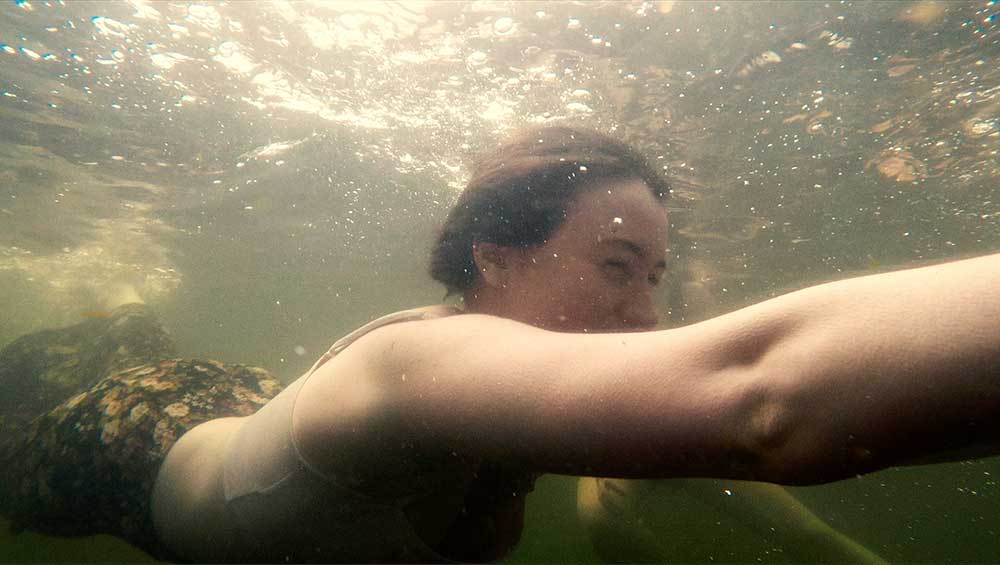
Rory Pilgrim, The Undercurrent, 2019-ongoing. HD film, 50:00.
Various venues, Limerick
31 August – 29 October 2023
by TOM DENMAN
The curatorial premise for the 40th edition of EVA International, the contemporary art biennial held in Limerick, Ireland, is based on the historic practice of gleaning: the collecting of unused crops after a harvest and redistributing them to people in need. The curator, Sebastian Cichocki, cites the theorist Stephen Wright’s use of the term to describe art that is not circumscribed, that is shared, and that sustains “the epistemic commons”, rather than art that necessarily involves the repurposing of materials (although several of the works here do this). Thus, gleaning potentially serves as a principle for climate activism – given its etymological link to land use – and anti-capitalism, insisting on the inseparability of the two. I am reminded of Jean-François Millet’s oil painting, The Gleaners, of 1857. This historical precedent is not mentioned in any of the accompanying essays – perhaps as a measure of caution, since it is now part of the western canon, and the biennial seeks to be canon-defying and international. And yet, to this (western) critic, the picture’s presence is still felt, not least given its eco-socialism, which was highly provocative at the time of its first exhibition and is still very relevant today.
The biennial includes works in various forms and mediums, exhibited at venues across town and at the University of Limerick, a half-hour bus ride from the town centre. Some works approach the biennial’s agricultural theme more literally than others. Neo-Agro (posters) (2011), an installation by Tamás Kaszás, directly references farming practices; his diagrammatic proposals for communal living and preindustrial, tool- as opposed to machine-driven agriculture are tacked to wooden fencelike structures – as if protesting the notion of land ownership. More allegorically, Olga Micińska (in collaboration with Mathild Clerc-Verhoeven) has created Journeylass crops (2023), a wooden framework made of trusses that support mysterious carvings: locks of hair, an outstretched arm. Parts of the structure are hinged like perpetually open or yielding gates, and it will later be repurposed on an Irish farm.
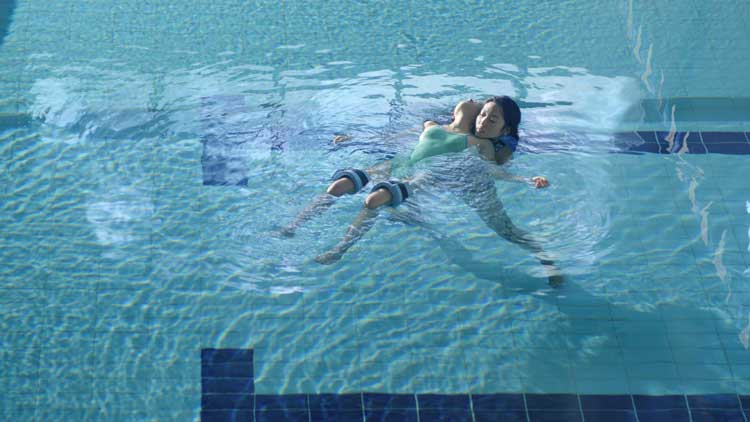
Jeamin Cha, Nameless Syndrome, 2022. Single channel video, 4K, colour, sound, 24:00. Image courtesy EVA International.
As a far-reaching and malleable metaphor, gleaning proves to be more than simply another way of framing a show about environmental catastrophe and its social repercussions. Much of this has to do with its various proposals for getting through, or healing from, today’s traumas and injustices. It is this positivity and collectivism that emotionally binds the programme, in part epitomised by John Carson’s Friend Map (1976), a network of photographs of the artist’s friends arranged on a map of Belfast. Because of this, throughout the biennial there is also a palpable woundedness. Jeamin Cha’s film Nameless Syndrome (2023) contemplates illnesses of women unidentifiable by conventional medicine, citing the historian Carlo Ginzburg’s observation that, for three famous cultural figures with medical training – Sigmund Freud, Arther Conan Doyle and the art connoisseur Giovanni Morelli – the answer to a conundrum was to be gleaned from outlying, apparently trivial details.

Clodagh Emoe, Reflections on a City Lot, 2023. Image courtesy EVA International.
A similar principle underpins Clodagh Emoe’s Reflections on a City Lot (2023), commissioned for the biennial. Set amid the ruins of two 15th-century houses and made by transferring plant dyes directly on to paper, the print depicts a weed that had been collected on the site earlier this year. On a monumental scale and attached to girders between two walls, the ethereal image itself seems to be holding what remains of the buildings together. Historically, ruins have been seen to approximate a repressed nature’s return and triumph over civilisation. But here nature and art appear to be working together, as Emoe asks us to consider this potential collaboration as the basis for civic and environmental renewal. And the print’s resemblance to a Rorschach test highlights this conversation’s subjective and metaphorical open-endedness.
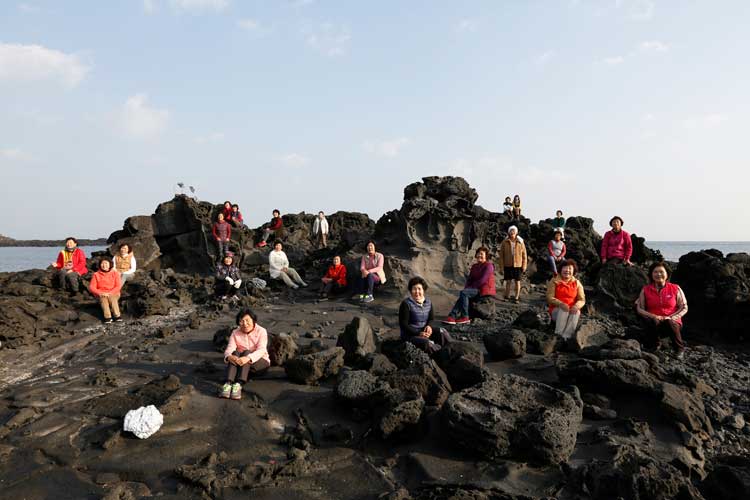
ikkibawiKrrr, Seaweed Story, 2022. Installation and single-channel video. Image courtesy of EVA International.
In several works, therapy is provided by music. The Seoul-based collective ikkibawiKrrr’s Seaweed Story (2022) centres on a film in which a choir of haenyeo – female divers living on South Korea’s Jeju Island – sings to inspire community spirit in the face of modernisation.
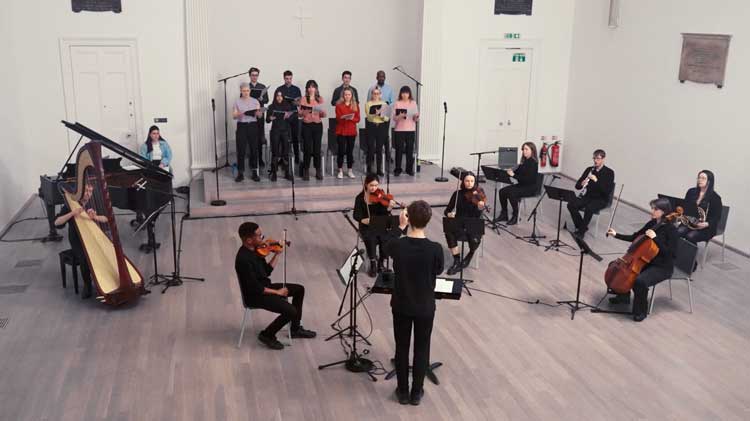
Rory Pilgrim, RAFTS, 2022. Image courtesy of EVA International.
Rory Pilgrim’s two films, The Undercurrent (2019) and Rafts (2020-22) (the latter of which earned the artist a Turner Prize nomination this year), correlate the climate crisis with the psychic pain of individuals, with the orchestral music interspersed with their stories operating as ritualistic healing. Less widely known are My-Musical Collective and Pidsoma Shelter, a refugee shelter and emergency kitchen based in Lviv, Ukraine, for people internally displaced by the Russian invasion. Their 2022 film My-musical (We-musical) comprises a variety of musical actions: a man making sandwiches sings a description of what he is doing; a woman in a yellow racing suit cheerleads Ukraine. The effect is uplifting, and their solidarity is felt, and yet so is the reality of their oppression; absurdism here suggests exhaustion, the effort of keeping it together.
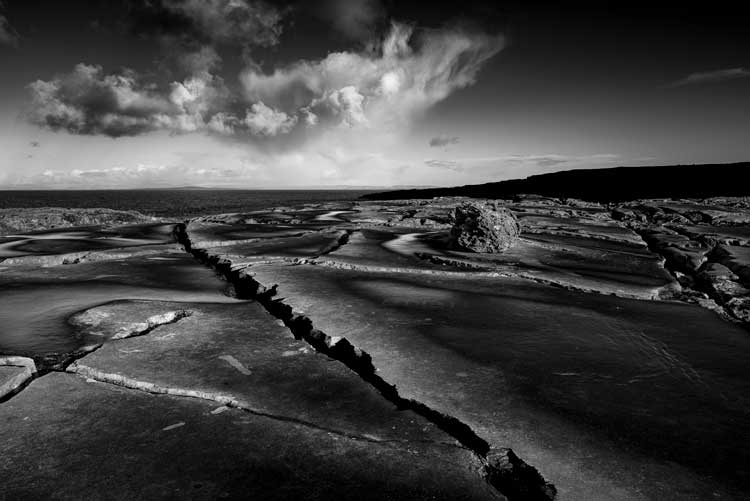
Óscar Mascareñas, Cracked moon on the ground, The Burren in County Clare, n.d. Image courtesy of EVA International.
Fundamental to the biennial’s ethos is the dismantlement of borders, especially those between art and life, and between the institutions of art and the wider world. In the garden of The People’s Museum of Limerick, Óscar Mascareñas’s Burrenscapes (2022), the artist’s sonic impressions of the landscape of The Burren in County Clare, is playing. Positioned as it is, permeating the well-groomed paths and hedges, the work often gels with the surrounding sounds of the city and its birds, blurring distinctions between the representation, manipulation, perception and reality of nature.

Navine G. Dossos, installation, interior of The Grove vegetarian kitchen, Cecil Street. Image courtesy EVA International.
At The Grove vegetarian kitchen on Cecil Street, Navine G Dossos has created an installation, a floor-to-ceiling mural depicting locally grown foods and tableware with diagrams and descriptions of their uses. Part of the mural charts, along the roots and stems of dandelions, the links between “gratitude”, “honouring our pain”, “seeing with new eyes”, and “going forth”. Dossos integrates psychic and bodily, visual and environmental goodness, and were it not for the wall text by the entrance, you might not realise you were participating in an art biennial.
Li Mu’s practice, showcased at Limerick City Gallery of Art, toys with the threshold between art and life, and with the epistemic commons, in a different way. Since 2012, the artist has been creating copies of artworks – mainly examples that explore reproducibility, by Sol LeWitt or Andy Warhol, for instance – with his family and neighbours in Qiuzhuang, a small, isolated town 800km (500 miles) from Beijing.
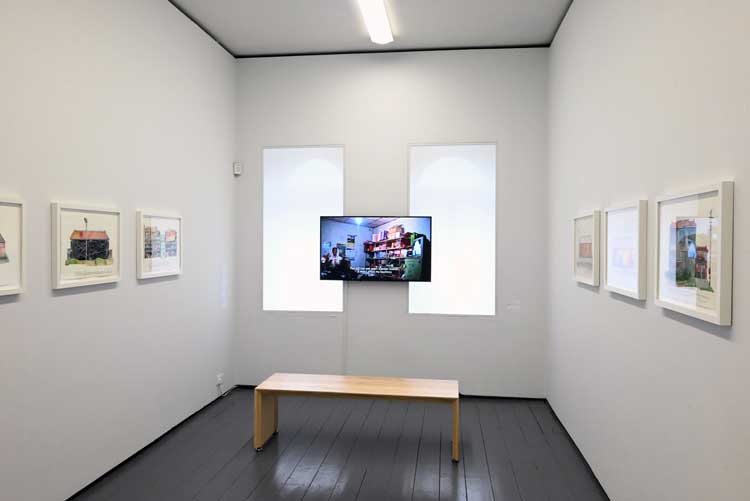
Li Mu, works from Qiuzhuang Project series, 2013. Image courtesy of EVA International.
In a video recording his practice (2015), people appear to be unaware of the artists in question, and there is a marked incongruity between their prestige in the international art world and their matter-of-fact reception in Qiuzhuang. The distribution of Warhol’s Mao (originally 1972-73) among the inhabitants’ homes raises a multitude of questions about what it means to live with art and the ever-varying values we give to it, all further complicated by being witnessed, as a work of art in itself, in an international art-viewing context.
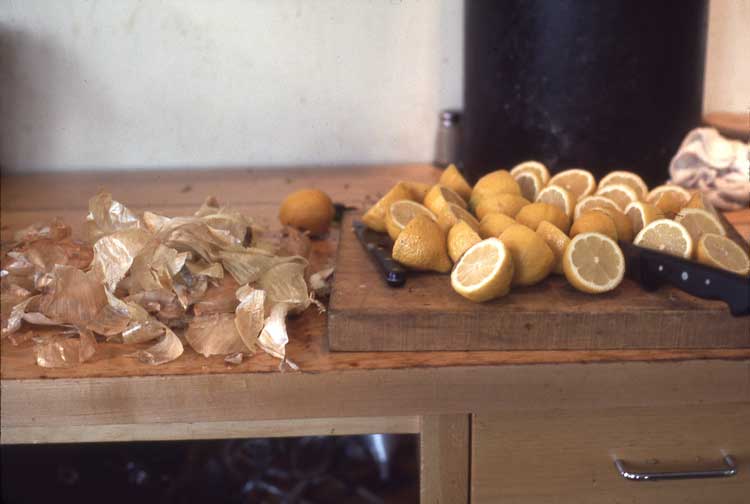
Gordon Matta-Clark, FOOD, 1971. Image courtesy EVA International.
While the biennial does not go as far back as Millet, it frequently acknowledges its own history – by including a number of works that dealt with gleaning (though without the term itself) in the second half of the 20th century. For example, there is an archival presentation of Gordon Matta-Clark’s Food, a restaurant he founded in New York in 1971 with the purpose of bringing artists together. And a number of photographs, diagrams and videos document the Slovenian collective OHO’s land art of the late 1960s and early 70s, experiments that led some of its members to abandon the art world and set up a commune in the countryside where they merged artistic and farming practices. The inclusion of such works puts into art historical perspective the land-focused works of more recent years. What is felt is that, as the art of ecology persists, its message becomes more urgent.